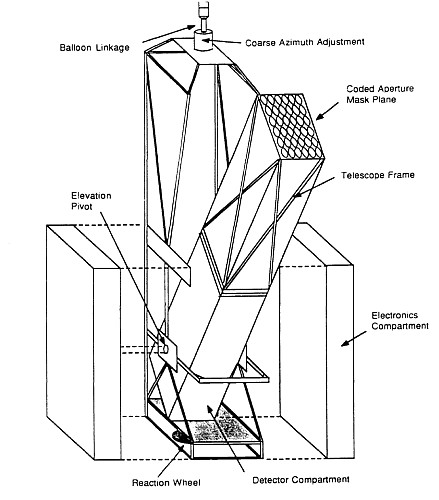Purpose of the flight and payload description
GRATIS was a telescope developed to perform the first arcminute imaging of cosmic sources in the 30~200 keV energy band, as an advance of a previous existing program called EXITE.
GRATIS was aimed to provide data relevant to several key problems in high energy astrophysics including the physical processes responsible for the high energy tail observed in the soft gamma-ray spectra of clusters of galaxies and the origin of both the diffuse and point source components of the gamma-ray emission from the Galactic Center.
A schematic diagram of the telescope and gondola package appears at left. The major components of the telescope were the coded aperture mask plane, detector compartment, and telescope frame. The gondola frame -made of aluminum and measuring 1 meter square by 4 meters long- supported the telescope and electronics compartment as well as housed the reaction wheel, elevation drive, and coarse azimuth control.
The gamma-ray telescope consisted of approximately 36 individual, co-aligned, smaller telescopes. Each of these was a one-dimensional imaging telescope consisting of a coded aperture mask and a collimator above a Csl crystal scintillator coupled to a position sensitive (in two dimensions) photomultiplier tube. The 36 small telescopes were all rotated with respect to one another and a two-dimensional image was reconstructed from the set of rotated one-dimensional images.
The shielding of the detector was a combination of active shields for charged particle rejection and passive shields to reduce atmospheric gamma radiation and x-ray fluorescence. The active shield was a plastic scintillator coupled to phototubes while the passive shield was a graded Z shield consisting of a 3 mm outer layer of lead, a middle layer of 1 mm of tin, and an inner layer of 1 mm copper.
The stabilized gondola was based on an inertial guidance system and a star camera. The gyro-based inertial guidance system provided three-axis pointing information with approximately 20 arcsecond precision. It was a true inertial guidance system with gyros, accelerometers, and an integral navigational processor. Once aligned and initialized, the system was capable of determining pointing direction, angular rates, latitude, longitude, and surface velocity. The gyros had high relative pointing precision, but had a slow drift. To correct it, was used a microchannel plate intensified CCD camera with an 8 inch diameter optical telescope as a star camera. Monitoring the video image at the ground station, allowed to correct for gyro drifts and maintain their absolute accuracy.
The elevation of the telescope was driven by a torque motor about the telescope's center of mass. The entire gondola slewed and tracked in azimuth to provide correct pointing for the telescope. The gondola had a coarse adjustment through a torque motor that torqued directly against the balloon cables. That torque motor was part of a zero static friction bearing assembly that decoupled the balloon from the gondola during fine azimuth adjustment and tracking. The fine adjustment was provided by a 36 inch diameter reaction wheel driven by another torque motor and mounted to the base of the gondola frame. All of the torque motors were controlled by pulse width modulated power amplifiers coordinated by the on-board 80186 microprocessor based computer system.
The instrument was launched three times, two in the United States and one in Australia. After the program's end, the technology used for the Sub Arcminute Pointing system from GRATIS was transferred and applied in the High Energy Focussing Telescope (HEFT), a more precise telescope aimed to observe high energy sources.
Details of the balloon flight
Balloon launched on: 10/17/1995 at 22:09 utc
Launch site: Australian Balloon Launching Station, Alice Springs, Australia
Balloon launched by: National Scientific Balloon Facility (NSBF)
Balloon manufacturer/size/composition: Zero Pressure Balloon SF3-459.37-080-NSXCHR-ST
Balloon serial number: W39.57-2-01
Flight identification number: 408N
End of flight (L for landing time, W for last contact, otherwise termination time): 10/18/1995 at 4:29 utc
Balloon flight duration (F: time at float only, otherwise total flight time in d:days / h:hours or m:minutes - ): 32 h
Landing site: 30 miles W of Ti Tree, Northern Territory, Australia
Payload weight: 6000 lbs
During this third and last flight of the instrument, a number of gamma ray sources, including Cen A and GRS 1915 were observed.
External references
- NASA Balloon Flights (1989-1998) in NASA Historical Data Book, Vol. VII: NASA Launch Systems, Space Transportation, Human Spaceflight, and Space Science, 1989-1998
- The Fall 1995 Australian campaign Head Newsletter No. 68 May 1996
- The gamma-ray arc-minute imaging system (GRATIS) - Mechanical design and expected performance Proc. SPIE 1159, EUV, X-Ray, and Gamma-Ray Instrumentation for Astronomy and Atomic Physics,
194If you consider this website interesting or useful, you can help me to keep it up and running with a small donation to cover the operational costs. Just the equivalent of the price of a cup of coffee helps a lot.


